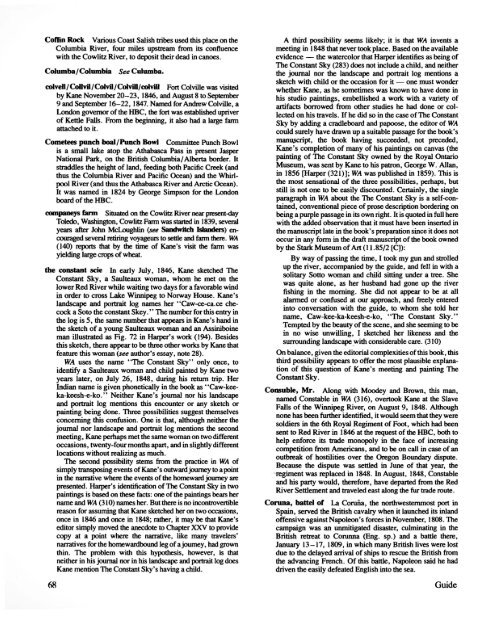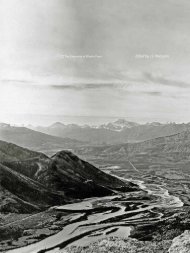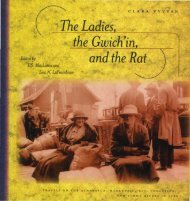Paul Kane's Journal of his Western Travels, 1846-1848 - History and ...
Paul Kane's Journal of his Western Travels, 1846-1848 - History and ...
Paul Kane's Journal of his Western Travels, 1846-1848 - History and ...
Create successful ePaper yourself
Turn your PDF publications into a flip-book with our unique Google optimized e-Paper software.
C<strong>of</strong>fin Rock Various Coast Salish tribes used t<strong>his</strong> place on the<br />
Columbia River, four miles upstream from its confluence<br />
with the Cowlitz River, to deposit their dead in canoes.<br />
Columba/Columbia See Culumba.<br />
coIveU/CoIIvll/Colvii/CoIviD/coIvill Fort Colville was visited<br />
by Kane November 20-23, <strong>1846</strong>, <strong>and</strong> August 8 to September<br />
9 <strong>and</strong> September 16-22, 1847. Named for Andrew Colville, a<br />
London governor <strong>of</strong> the HBC, the fort was established upriver<br />
<strong>of</strong> Kettle Falls. From the beginning, it also had a large fann<br />
attached to it.<br />
Cometees punch boat/Punch Bowl Committee Punch Bowl<br />
is a small lake atop the Athabasca Pass in present Jasper<br />
National Park, on the British Columbia/ Alberta border. It<br />
straddles the height <strong>of</strong> l<strong>and</strong>, feeding both Pacific Creek (<strong>and</strong><br />
thus the Columbia River <strong>and</strong> Pacific Ocean) <strong>and</strong> the Whirlpool<br />
River (<strong>and</strong> thus the Athabasca River <strong>and</strong> Arctic Ocean).<br />
It was named in 1824 by George Simpson for the London<br />
board <strong>of</strong> the HBC.<br />
compaoeys fann Situated on the Cowlitz River near present-day<br />
Toledo, Washington, Cowlitz Fann was started in 1839, several<br />
years after John McLoughlin (see S<strong>and</strong>witch Isl<strong>and</strong>ers) encouraged<br />
several retiring voyageurs to settle <strong>and</strong> fann there. WA<br />
(140) reports that by the time <strong>of</strong> <strong>Kane's</strong> visit the fann was<br />
yielding large crops <strong>of</strong> wheat.<br />
the constant scie In early July, <strong>1846</strong>, Kane sketched The<br />
Constant Sky, a Saulteaux woman, whom he met on the<br />
lower Red River while waiting two days for a favorable wind<br />
in order to cross Lake Winnipeg to Norway House. <strong>Kane's</strong><br />
l<strong>and</strong>scape <strong>and</strong> portrait log names her "Caw-ce-ca.ce checock<br />
a Soto the constant Skey. " The number for t<strong>his</strong> entry in<br />
the log is 5, the same number that appears in <strong>Kane's</strong> h<strong>and</strong> in<br />
the sketch <strong>of</strong> a young Saulteaux woman <strong>and</strong> an Assiniboine<br />
man illustrated as Fig. 72 in Harper's work (194). Besides<br />
t<strong>his</strong> sketch, there appear to be three other works by Kane that<br />
feature t<strong>his</strong> woman (see author's essay, note 28).<br />
WA uses the name "The Constant Sky" only once, to<br />
identify a Saulteaux woman <strong>and</strong> child painted by Kane two<br />
years later, on July 26, <strong>1848</strong>, during <strong>his</strong> return trip. Her<br />
Indian name is given phonetically in the book as "Caw-keeka-keesh-e-ko.<br />
,. Neither <strong>Kane's</strong> journal nor <strong>his</strong> l<strong>and</strong>scape<br />
<strong>and</strong> portrait log mentions t<strong>his</strong> encounter or any sketch or<br />
painting being done. Three possibilities suggest themselves<br />
concerning t<strong>his</strong> confusion. One is that, although neither the<br />
journal nor l<strong>and</strong>scape <strong>and</strong> portrait log mentions the second<br />
meeting, Kane perhaps met the same woman on two different<br />
occasions, twenty-four months apart, <strong>and</strong> in slightly different<br />
locations without realizing as much.<br />
The second possibility stems from the practice in WA <strong>of</strong><br />
simply transposing events <strong>of</strong> <strong>Kane's</strong> outward journey to a point<br />
in the narrative where the events <strong>of</strong> the homeward journey are<br />
presented. Harper's identification <strong>of</strong> The Constant Sky in two<br />
paintings is based on these facts: one <strong>of</strong> the paintings bears her<br />
name <strong>and</strong> WA (310) names her. But there is no incontrovertible<br />
reason for assuming that Kane sketched her on two occasions,<br />
once in <strong>1846</strong> <strong>and</strong> once in <strong>1848</strong>; rather, it may be that <strong>Kane's</strong><br />
editor simply moved the anecdote to Chapter XXV to provide<br />
copy at a point where the narrative, like many travelers'<br />
narratives for the homewardbound leg <strong>of</strong> a joumey, had grown<br />
thin. The problem with t<strong>his</strong> hypothesis, however, is that<br />
neither in <strong>his</strong> journal nor in <strong>his</strong> l<strong>and</strong>scape <strong>and</strong> portrait log does<br />
Kane mention The Constant Sky's having a child.<br />
A third possibility seems likely; it is th~t WA invents a<br />
meeting in <strong>1848</strong> that never took place. Based on the available<br />
evidence - the watercolor that Harper identifies as being <strong>of</strong><br />
The Constant Sky (283) does not include a child, <strong>and</strong> neither<br />
the journal nor the l<strong>and</strong>scape <strong>and</strong> portrait log mentions a<br />
sketch with child or the occasion for it - one must wonder<br />
whether Kane, as he sometimes was known to have done in<br />
<strong>his</strong> studio paintings, embellished a work with a variety <strong>of</strong><br />
artifacts bono wed from other studies he had done or collected<br />
on <strong>his</strong> travels. If he did so in the case <strong>of</strong> The Constant<br />
Sky by adding a cradleboard <strong>and</strong> papoose, the editor <strong>of</strong> WA<br />
could surely have drawn up a suitable passage for the book's<br />
manU$Cript, the book having succeeded, not preceded,<br />
<strong>Kane's</strong> completion <strong>of</strong> many <strong>of</strong> <strong>his</strong> paintings on canvas (the<br />
painting <strong>of</strong> The Constant Sky owned by the Royal Ontario<br />
Museum, was sent by Kane to <strong>his</strong> patron, George W. Allan,<br />
in 1856 [Harper (321)]; WA was published in 1859). T<strong>his</strong> is<br />
the most sensational <strong>of</strong> the three possibilities, perhaps, but<br />
still is not one to be easily discounted. Certainly, the single<br />
paragraph in WA about the The Constant Sky is a self-contained,<br />
conventional piece <strong>of</strong> prose description bordering on<br />
being a purple passage in its own right. It is quoted in full here<br />
with the added observation that it must have been inserted in<br />
the manuscript late in the book's preparation since it does not<br />
occur in any fonn in the draft manuscript <strong>of</strong> the book owned<br />
by the Stark Museum <strong>of</strong> Art (11.85/2 [Cn:<br />
By way <strong>of</strong> passing the time, I took my gun <strong>and</strong> strolled<br />
up the river, accompanied by the guide, <strong>and</strong> fell in with a<br />
solitary Sotto woman <strong>and</strong> child sitting under a tree. She<br />
was quite alone, as her husb<strong>and</strong> had gone up the river<br />
fishing in the morning. She did not appear to be at all<br />
alanned or confused at our approach, <strong>and</strong> freely entered<br />
into conversation with the guide, to whom she told her<br />
name, Caw-kee-ka-keesh-e-ko, "The Constant Sky."<br />
Tempted by the beauty <strong>of</strong> the scene, <strong>and</strong> she seeming to be<br />
in no wise unwilling, I sketched her likeness <strong>and</strong> the<br />
surrounding l<strong>and</strong>scape .with considerable care. (310)<br />
On balance, given the editorial complexities <strong>of</strong> t<strong>his</strong> book, t<strong>his</strong><br />
third possibility appears to <strong>of</strong>fer the most plausible explanation<br />
<strong>of</strong> t<strong>his</strong> question <strong>of</strong> <strong>Kane's</strong> meeting <strong>and</strong> painting The<br />
Constant Sky .<br />
CODSuble, Mr. Along with Moodey <strong>and</strong> Brown, t<strong>his</strong> man,<br />
named Constable in WA (316), overtook Kane at the Slave<br />
Falls <strong>of</strong> the Winnipeg River, on August 9, <strong>1848</strong>. Although<br />
none has been further identified, it would seem that they were<br />
soldiers in the 6th Royal Regiment <strong>of</strong> Foot, which had been<br />
sent to Red River in <strong>1846</strong> at the request <strong>of</strong> the HBC, both to<br />
help enforce its trade monopoly in the face <strong>of</strong> increasing<br />
competition from Americans, <strong>and</strong> to be on call in case <strong>of</strong> an<br />
outbreak <strong>of</strong> hostilities over the Oregon Boundary dispute.<br />
Because the dispute was settled in June <strong>of</strong> that year, the<br />
regiment was replaced in <strong>1848</strong>. In August, <strong>1848</strong>, Constable<br />
<strong>and</strong> <strong>his</strong> party would, therefore, have departed from the Red<br />
River Settlement <strong>and</strong> traveled east along the fur trade route.<br />
Corona, battel<strong>of</strong> La Coruiia, the northwestemmost port in<br />
Spain, served the British cavalry when it launched its inl<strong>and</strong><br />
<strong>of</strong>fensive against Napoleon's forces in November, 1808. The<br />
campaign was an unmitigated disaster, culminating in the<br />
British retreat to Corunna (Eng. sp.) <strong>and</strong> a battle there,<br />
January 13-17, 1809, in which many British lives were lost<br />
due to the delayed arrival <strong>of</strong> ships to rescue the British from<br />
the advancing French. Of t<strong>his</strong> battle, Napoleon said he had<br />
driven the easily defeated English into the sea.<br />
Guide
















